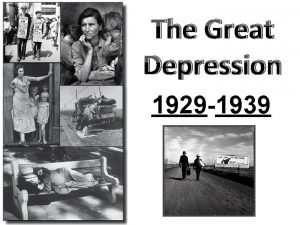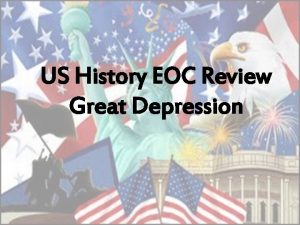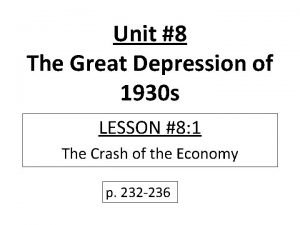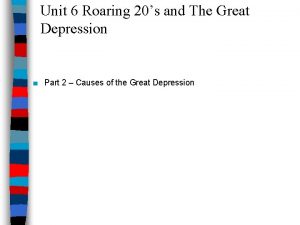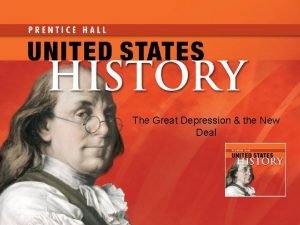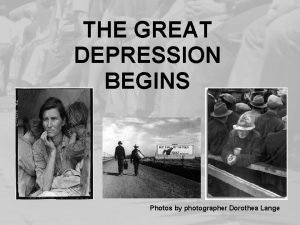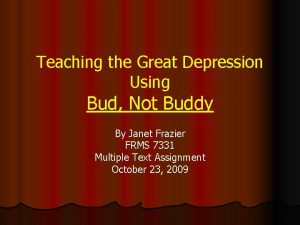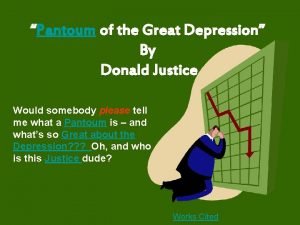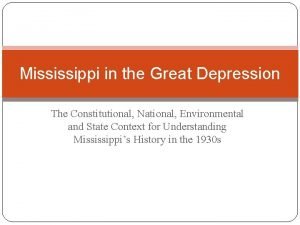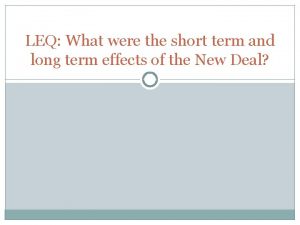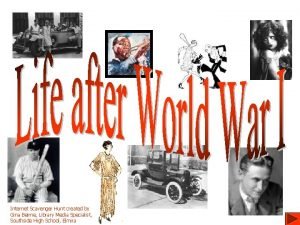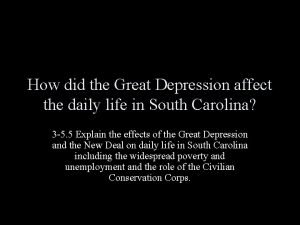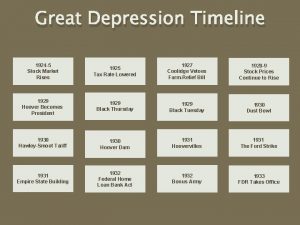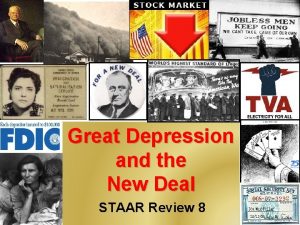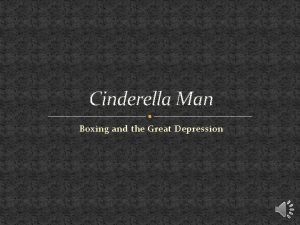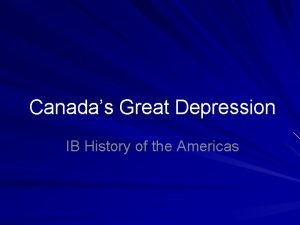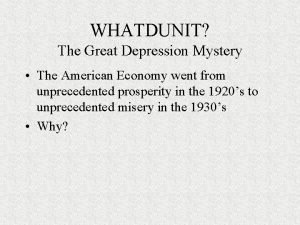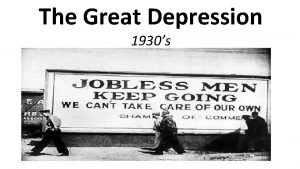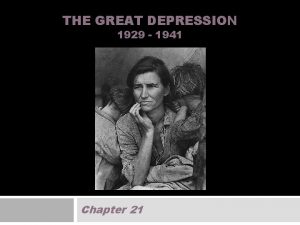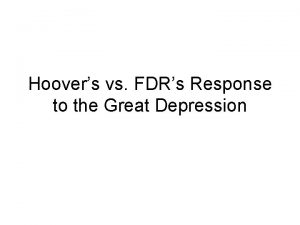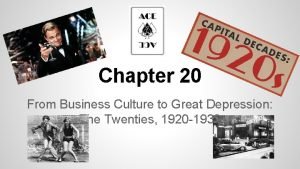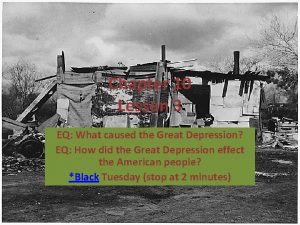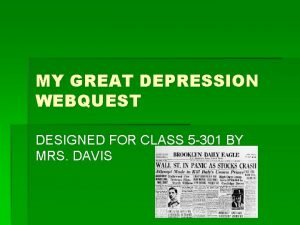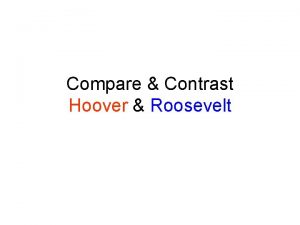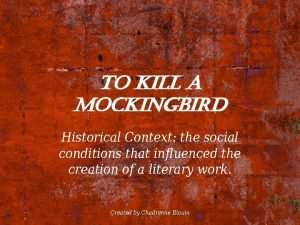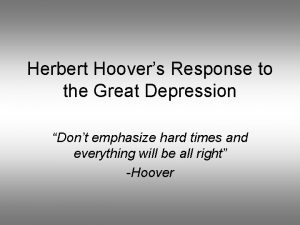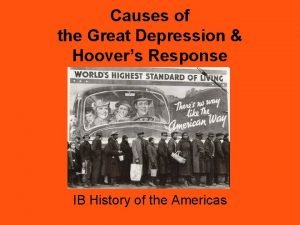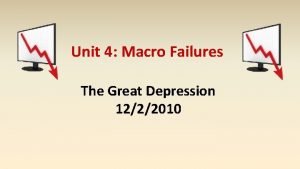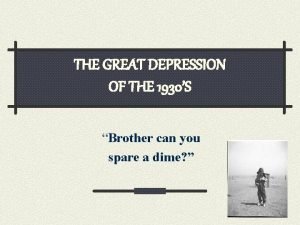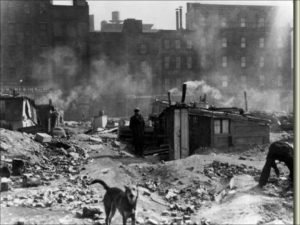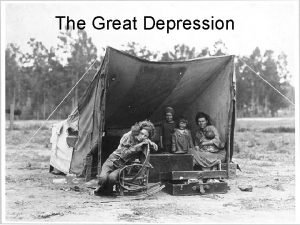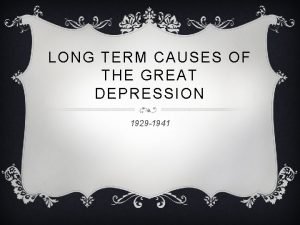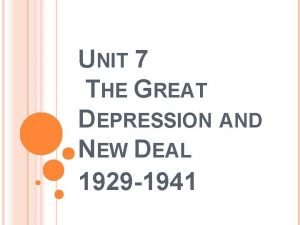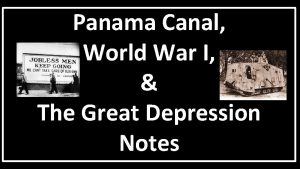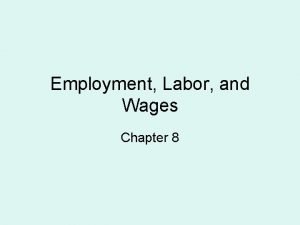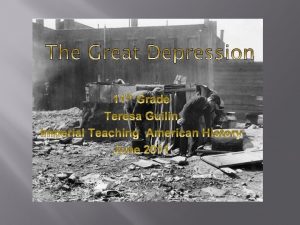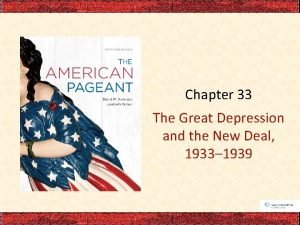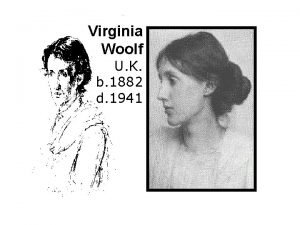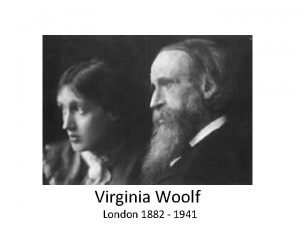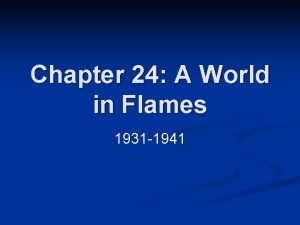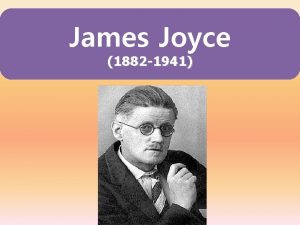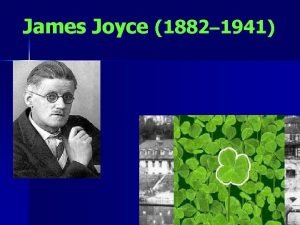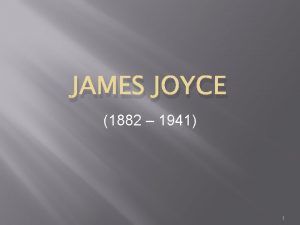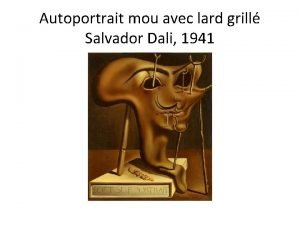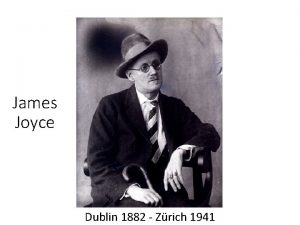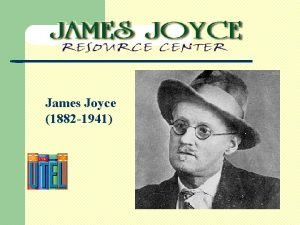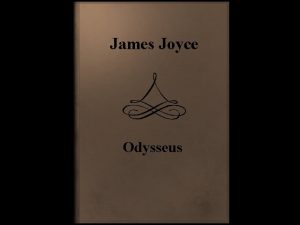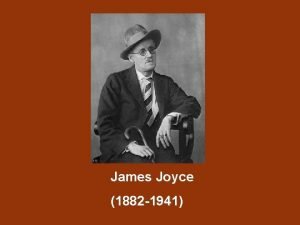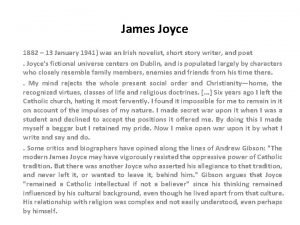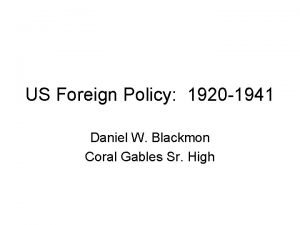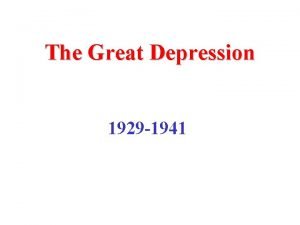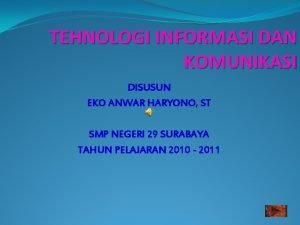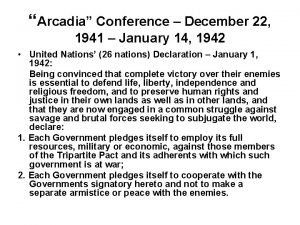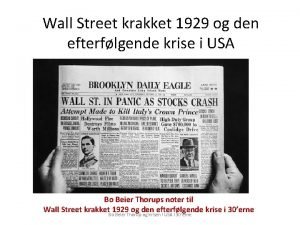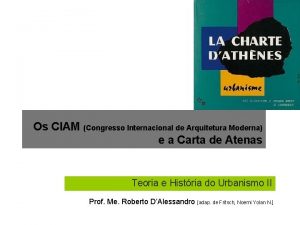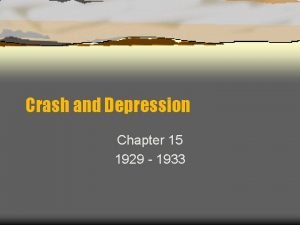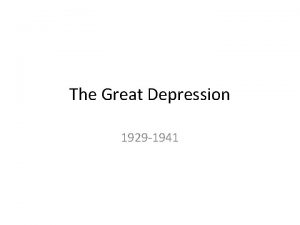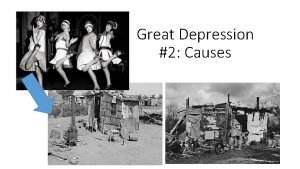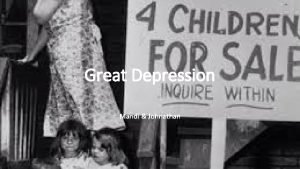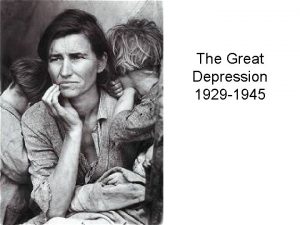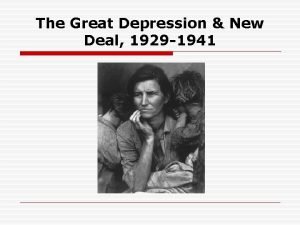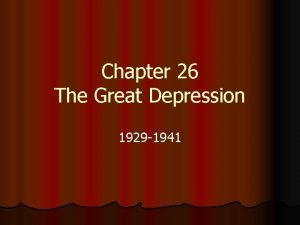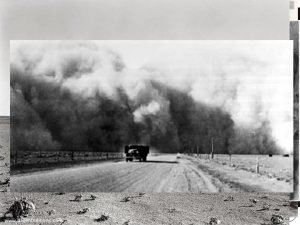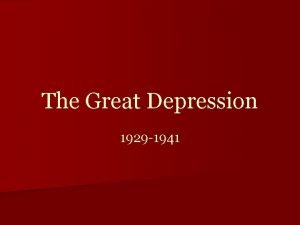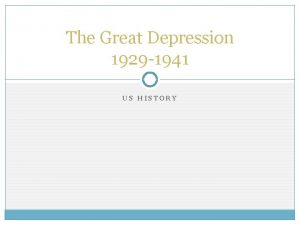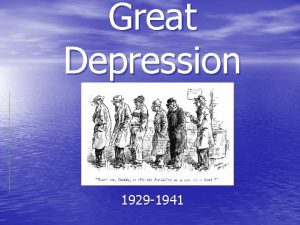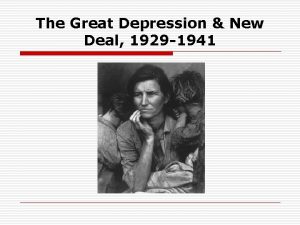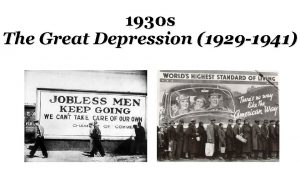1929 1941 The Great Depression Economics Intro Review

















































































































- Slides: 113

1929 -1941 The Great Depression


Economics…

Intro Review � � � � � Recession unemployment depression law of supply and demand securities over-speculation foreclosures NYSE Wall Street bond on the margin overproduction brokers stock insider trading interest Business Cycle bank runs A bull market is up—it’s a seller’s market A bear market is down—it’s a buyer’s market

From Twenties to Thirties 1920 S � � � � Economic prosperity Optimism Fads and slang Prohibition Organized crime/bootleg Heroes Movies Silent Cal Laissez-faire New jobs Bull market Ideals of rural America Migration to cities Fundamentalism Republicans in power 1930 S � � � � Economic depression Pessimism Traditional values Repeal of prohibition Public enemies/theft Political demagogues More movies/escapism FDR’s fireside chats New Deal regulation 25% unemployment Bear Market Dust Bowl Migration to California Rugged individualism Democrats in power

Vocabulary—Topic 5—see p. 298 1. Business Cycle 2. Great Crash—major dip in the stock market in October 1929 3. Black Tuesday 4. Rugged Individualism--idea of a person standing on his own without help from others 5. Breadlines/Soup Kitchens 6. Depression 7. Bonus Army 8. Hoovervilles 9. Dust Bowl 10. Dorothea Lange 11. Hobo Signs—marks by the homeless outside a home indicating help or no help 12. “Riding the Rails” 13. The New Deal � —Hoover Blanket � —Hoover Flag � —Shanty

The Great Recession of 2008 �http: //www. youtube. com/watch? v=Q 0 z. EXd. D O 5 JU (Video: “The Crisis of Credit”)

Economic Factors 2012 -13

I. Panic of 1929 �A. Overproduction (led to lay-offs) �B. Under-consumption (led to more lay-offs) �C. Unsound financial practices led to “bank runs” (bad loans, buying on the margin) �D. Stock Market Crash—Oct. 29, 1929

Who is to blame? � Secretary of Treasury, Andrew Mellon? � The Federal Reserve? � High tariffs?



II. Hoover Tries to Fight the Depression �A. Ideas of rugged individualism �B. Agricultural Marketing Act �C. Reconstruction Finance Corporation �D. Limited program of federal works �E. Encouraged local projects �F. Extended WWI European Loans �G. Hawley-Smoot Tariff—failure—depression got worse!


“Brother, Can You Spare a Dime? ” (song) � http: //www. youtube. co m/watch? v=eih 67 rl. GNh U � Recorded by Bing Crosby in 1931

“We’re in the Money” � http: //www. youtube. com /watch? v=_r 3 Kd. TL 6 mjk � Film: Gold Diggers of 1933 � Song still used to indicate a bull market over a bear market

III. Election of 1932 �A. 13 million unemployed �B. Foreclosures on homes and farms �C. Breadlines and soup kitchens �D. Banks failing �E. Hoover ran for re-election—people blamed him for the depression �F. Gov. Franklin D. Roosevelt of NY won in a landslide �G. Both houses of Congress became Democratic majorities

Breadline

Bonus Army � http: //www. youtube. com/watch_popup? f eature=player_embe dded&v=s. NOs. IB 5 V MSQ

Bonus Army

Hooverville

Election of 1932


IV. Life of FDR �A. Early years of wealth and privilege— related to TR—married to Eleanor—lawyer �B. NY politician �C. Assistant sec. of navy �D. VP candidate in 1920 �E. 1921—polio led to paralysis of his legs— used exercise, steel braces, cane �F. 1928 -33—governor of NY

Franklin and Eleanor

”Happy Days are Here Again” campaign song

V. “Happy Days are Here Again!” �A. Greatest peacetime crisis in history �B. Inauguration—March 1933—later the 20 th amendment changed inauguration to January (shorter “Lame Duck”) �C. “The only thing we have to fear is fear itself” �D. Promised “relief, recovery and reform” �E. Promised a “New Deal” for people �F. Fireside chats (on radio) reassured people

First Hundred Days… �President Roosevelt presented an “alphabet soup” of programs �All presidents are now judged by their first 100 days in office �“Brain Trust”—FDR’s advisors were university professors and experts




The New Deal �Based on ideas of John Maynard Keynes (Keynesian Economics) � ‘‘pump priming’’ or ‘‘priming the pump’’ (government spending to stimulate the economy)

VI. New Deal Programs—Financial �A. National Banking Holiday—halted bank runs and provided safe banks—he closed the banks �B. Gold standard ended �C. FDIC—Federal Deposit Insurance Corporation—protected bank deposits! �D. Federal Securities Act �E. SEC—Securities and Exchange Commission (headed by Joe Kennedy!)

FDR’s “ Bank Holiday”


VII. New Deal Programs—Aid for Unemployed �A. FERA—Federal Emergency Relief Administration (gave “relief” $) �B. PWA—Public Works Administration (roads, buildings etc. ) �C. WPA—Works Progress Administration (added art projects) �D. CCC—Civilian Conservation Corps (built campsites) �E. NYA—National Youth Administration

New Deal in Texas �http: //livingnewdeal. org/us/tx/denton-tx/

Mary Mac. Leod Bethune—head of NYA

CCC

PWA in Denton

VIII. New Deal Programs—Industry and Agriculture �A. NRA—National Recovery Administration �B. Sec. of State Cordell Hull lowered tariffs for better international trade �C. AAA—Agricultural Adjustment Act


IX. New Deal Programs--Labor �A. NLRA (Wagner Act)—National Labor Relations Act—made unions legal �B. Social Security Act—retirement funds �C. Fair Labor Standards Act—protected women in the workplace—established minimum wage and maximum hours

Frances Perkins �Secretary of Labor �First Woman Cabinet Member (Note: Dept. of Labor started by Wilson-1913)

Social Security Card

X. New Deal--Housing �A. HOLC--Home Owners Loan Corporation �B. FHA—Federal Housing Administration �C. USHA—U. S. Housing Authority

FHA

XI. New Deal—Conservation and Development �A. TVA—Tennessee Valley Authority �B. Hoover Dam (Boulder Dam), Grand Coulee Dam, and others �C. Rural Electrification Act (all provided electricity in rural areas)

Hoover Dam—Las Vegas, Nevada

XII. Other Programs �A. 21 st Amendment Passed—repealed 18 th (ended prohibition)— 1933 �B. FCC—Federal Communications Commission �C. Motor Carrier Act �D. Civil Aeronautics Act �E. U. S. Maritime Commission

FCC

And… �F. Food, Drug, Cosmetics Act �G. Good Neighbor Policy (friendly to Latin America) �H. Became friendly to U. S. S. R. (Soviet Union/Russia) �I. FDR re-elected in 1936 (against Al Landon)

Lame Duck Amendment

XIII. New Deal Criticism �A. Too much power of the federal government? �B. Is it the job of the government to provide for the poor? �C. Supreme Court ruled against some programs (NRA, AAA) �D. Court Packing Scheme—FDR tried to increase the number of liberal justices— DISASTER!

Court packing

Too much power?

…more criticism �E. FDR defied the two-term tradition and ran four times �F. Money wasted and not enough help— 8 million still unemployed in 1939 �G. Record deficits ($49 billion in 1941)

Too much spending?

XIV. New Deal Praise � A. Programs were not a cure for the depression but gave people relief during the depression � B. It broadened the power of what government can do � C. Some believe that the New Deal saved the U. S. from disaster and restored the confidence of the people � D. By “priming the pump” (putting money into the economy), FDR helped people—used ideas of economist, Keynes

First Lady � Eleanor was ‘‘the president’s legs’’—travelled � Civil Rights advisor to FDR (Black Cabinet) � Had a news column called ‘‘My Day’’ � Later named U. S. ambassador to the United Nations


Which programs do we still have today? �Social Security �SEC �FDIC �FHA �HOLC �USHA �FCC �FDA �TVA �Unemployment insurance �Minimum wage �forty-hour week

Note: �FDR’s New Deal did not end The Great Depression �It provided temporary relief (like cold medicine) �WWII ended The Depression for the U. S.

Current Unemployment stats—Jan. 2014 � Texas: 6. 5% � Denton County: 5. 2% � Growth of 257, 000 new � Denton ISD is number 4 jobs in the last year in the state in new home growth

Review Terms and Ideas � http: //www. youtube. com/w atch? v=Z_Ovo 1 ar. A-o See FDR’s First Inaugural Address � http: //www. youtube. com/w atch? v=am. Npx. QANk 0 M “The only thing we have to fear is fear itself. ” � � � � � Hoover FDR Eleanor Roosevelt New Deal Hundred Days Brain Trust Social Security Pump Priming Alphabet Soup Bank Holiday Frances Perkins PWA REA Fireside Chats FDIC 20 th Amendment 21 st Amendment Court Packing Scheme

Bureaucracy � a system of � The details of the New Deal created a big bureaucratic government in which most of the important decisions are made by state officials rather than by elected representatives

Dust Bowl--Result of overgrazing, overfarming and a seven year drought

Dorothea Lange--photographer

Hobo Symbols

Penny Auctions

Gangsters �Bonnie and Clyde �John Dillinger �Arrest of Al Capone

21 st Amendment

Demagogues � Huey Long of Louisiana (“The Kingfish”) � John Lewis, labor leader � Father Coughlin, radio personality � Dr. Townsend

Cultural Expressions During The Great Depression

The Grapes of Wrath � � � � http: //www. neabigread. org/books/ grapesofwrath/ Novel by John Steinbeck, published in 1939 Film made in 1940—Directed by John Ford Inspired by Dorothea Lange’s photography Main Character: Tom Joad (parolee, sharecropper, migrant worker) Setting: 1930 s Oklahoma Dust Bowl to California (Route 66) Biblical Themes: journey, wandering in the desert, trials of Job, “love thy neighbor”

Cesar Chavez � Read the memoir � Cesar Chavez was a real “Tom Joad” in the 1960 s. � His childhood experiences as a migrant worker during the 1930 s influenced his work in the 1960 s.

Will Rogers � American entertainer, journalist, folk hero � Beloved humorist � Known for his comments on politics and everyday life � “I am not a member of any organized political party. I am a Democrat. ” � “I never met a man I didn’t like. ” � Died in a plane crash with aviator, Wiley Post, in Alaska in 1935

Games

Heroes Marian Anderson Jesse Owens

Big Bands and Swing

Sports �‘‘Today I consider myself the luckiest man on the face of the earth. ’’ �Lou Gehrig, NY Yankees

Quotable � Mr. Ruth, why do you make more money than President Hoover? � “I had a better year than he did. ”

Music—Pete Seeger and Woody Guthrie This land is my land This land is your land From California To the New York island From the redwood forest. To the Gulf Stream waters This land was made for you and me.

Bonus Army

“God Bless America” by Irving Berlin � Sung by Kate Smith, Armistice Day of 1938 � Inspired the country on the eve of WWII � Made more money than any other song before � All money was donated to Boy Scouts and Girl Scouts of America

Empire State Building �World’s tallest building in 1931 �New York City

Movies

The Hays Code—Before and After

Landmark Movies

Political Idealism—Frank Capra Film

The Real Public Enemy

Scottsboro Case

Artists—Diego Rivera and Thomas Hart Benton

San Francisco’s Golden Gate Bridge

The Hindenberg Disaster � German Airship �Lakehurst, NJ �May, 1937 � ‘‘Oh, the humanity of it all!’’

Comics

Labor � Sit down strike by automobile manufacturers union � Ford Motor Plant in Detroit � Known for “corporate welfare”

Whatever happened to… � Al Capone? Arrested for tax evasion and died at Alcatraz � Calvin Coolidge? Died and there was a state funeral � Charles Lindbergh? His baby was kidnapped and killed—the family moved to England

Overseas… � Totalitarian states were using oppressive ways to fight the Great Depression

What brought the end to The Great Depression? �The surprise attack on Pearl Harbor by Japan on December 7, 1941 �This was the beginning of World War II for the U. S.

Vocabulary � 1. Business Cycle—series of economic events covering prosperity to depression through the years � 2. Great Crash—major dip in the stock market in October 1929 � 3. Black Tuesday—October 29, 1929—day of stock market crash and beginning of Great Depression � 4. “Rugged Individualism”—idea of a person standing on his own without help from others � 5. breadlines/soup kitchens—free food in cities during the depression � 6. depression—severe economic downturn (low business activity, low prices and wages, high unemployment)

Vocabulary continued � 7. Bonus Army—a protest march of veterans in Washington who wanted their WWI benefits—Hoover sent the army to control them � 8. Hoovervilles—series of shacks and shelters for homeless during Depression � 9. Dust Bowl—result of drought on the Great Plains � 10. Dorothea Lange—photographer of the depression, especially migrant workers � 11. Hobo Signs—marks by the homeless outside a home indicating help or no help � 12. riding the rails—teens left home and jumped on trains to find work and adventure � 13. New Deal—FDR’s relief, recovery and reform programs designed to battle the Great Depression

APUSH Details…

First New Deal— ‘‘First Hundred Days’’--1933 -35 Emergency Banking Relief Act Banking Act of 1933 (Glass Steagall Act) established FDIC Truth in Securities Act --SEC HOLC, FHA Gold taken out of circulation—abandoned gold standard FERA led by Harry Hopkins CCC—for 18 -24 aged men whose parents were on relief PWA (led by Harold Ickes) Civil Works Administration—extended PWA AAA Federal Farm Loan Act, Farm Credit Admin. , Frazier-Lemke Farm Bankruptcy Act NIRA and NRA (declared unconstitutional—Schechter v. U. S. ) TVA

Opposition to First New Deal � Conservatives said that FDR was a ‘‘traitor to his class’’ � Some thought NRA favored big business by setting prices too high � AAA did not benefit sharecroppers � American Liberty League promoted conservative candidates � Dr. Francis E. Townsend proposed The Old Age Revolving Pension Fund � Sen. Huey Long proposed a ‘‘Share the Wealth’’ program � National Union for Social Justice—Father Coughlin (sounded fascist!)

Second New Deal— ’’Second Hundred Days’’— 1935 -38 �WPA �NYA �REA �Resettlement Administration (RA) �Wagner Act �NLRB �Social Security Act �Banking Act of 1935 �Public Utility Holding Co/Wheeler-Rayburn Act �Revenue Act—increased income tax �Motor Carrier Act

Election of 1936—FDR ran against… �Governor Alfred Landon of Kansas, the Republican candidate �Union Party—Congressman Lemke of ND (Father Coughlin was denounced by Catholic leaders and Dr. Townsend’s following decreased) �Socialist candidate, Norman Thomas �FDR won all states except Maine and Vermont

“Indian New Deal” � Indian Reorganization Act of 1934 � partially reversed the Dawes Act � restored the tribal basis of Indian life

Election of 1940 FDR vs. Wendell Willkie of Indiana

Election of 1944 FDR vs. Thomas Dewey of NY


FDR’s Vice Presidents �John Nance Garner of Texas 1933 -41 �Henry Wallace of Iowa 1941 -45 �Harry S Truman of Missouri 1945

 Great depression 1929
Great depression 1929 Stock market crash cartoon 1929
Stock market crash cartoon 1929 Main idea
Main idea Black tuesday political cartoon
Black tuesday political cartoon Book review intro
Book review intro Government study guide unit 1
Government study guide unit 1 Great depression vocabulary
Great depression vocabulary Rarig great depression
Rarig great depression Great depression
Great depression Tennessee valley authority
Tennessee valley authority Foreclosure great depression
Foreclosure great depression Five effects of the great depression
Five effects of the great depression Five effects of the great depression
Five effects of the great depression How did the great depression impact the world
How did the great depression impact the world Dawes plan
Dawes plan Bud not buddy
Bud not buddy Pantoum of the great depression analysis
Pantoum of the great depression analysis Summary of great depression
Summary of great depression Cpi during the great depression
Cpi during the great depression Okies great depression
Okies great depression The great depression leq
The great depression leq Roaring twenties scavenger hunt answers
Roaring twenties scavenger hunt answers How did the great depression affect daily life
How did the great depression affect daily life Timeline of the great depression
Timeline of the great depression Great depression causes
Great depression causes Mexican repatriation apush
Mexican repatriation apush Hoovervilles
Hoovervilles Birth rate during the great depression
Birth rate during the great depression Overspeculation great depression
Overspeculation great depression Great depression vocab
Great depression vocab Chapter 14 the great depression begins vocabulary
Chapter 14 the great depression begins vocabulary Poverty during the great depression
Poverty during the great depression Http://www.history.com/topics/great-depression
Http://www.history.com/topics/great-depression Hawley-smoot tariff great depression
Hawley-smoot tariff great depression Module 9 lesson 2
Module 9 lesson 2 Great depression budget activity
Great depression budget activity Hoover v. fdr responses to the great depression
Hoover v. fdr responses to the great depression Laissez faire great depression
Laissez faire great depression Laissez faire great depression
Laissez faire great depression From business culture to great depression
From business culture to great depression Dust bowl acrostic poem
Dust bowl acrostic poem Hoovervilles great depression
Hoovervilles great depression Great depression political cartoons
Great depression political cartoons Pros and cons of the great depression
Pros and cons of the great depression Great depression vocabulary jeopardy
Great depression vocabulary jeopardy Chapter 22 the great depression begins
Chapter 22 the great depression begins Great depression
Great depression Great depression webquest
Great depression webquest Hoover and roosevelt compare and contrast
Hoover and roosevelt compare and contrast Social context of to kill a mockingbird
Social context of to kill a mockingbird Hoovers response to the great depression
Hoovers response to the great depression Great depression
Great depression What was hoover's response to the great depression
What was hoover's response to the great depression Great depression
Great depression Great depression
Great depression Dust bowl map
Dust bowl map High tariffs great depression
High tariffs great depression Great depression photographer
Great depression photographer What was hoover’s response to the depression?
What was hoover’s response to the depression? Great depression
Great depression Hoover's poor farm tobacco fund
Hoover's poor farm tobacco fund What were the long term causes of the great depression
What were the long term causes of the great depression The great depression outline
The great depression outline Great depression journal entry
Great depression journal entry New deal
New deal Hawley smoot tariff apush
Hawley smoot tariff apush Wall street crash of 1929
Wall street crash of 1929 What was the great depression
What was the great depression Great depression jeopardy
Great depression jeopardy Ww1 to great depression cloze notes
Ww1 to great depression cloze notes Chapter 8 employment labor and wages
Chapter 8 employment labor and wages Describe the human toll of the great depression
Describe the human toll of the great depression Chapter 33 the great depression and the new deal
Chapter 33 the great depression and the new deal Maastricht university school of business and economics
Maastricht university school of business and economics Mathematical economics vs non mathematical economics
Mathematical economics vs non mathematical economics 1941-1882
1941-1882 1941-1882
1941-1882 Di cavalcanti mulata com pássaro
Di cavalcanti mulata com pássaro A world in flames, 1931-1941
A world in flames, 1931-1941 1941-1882
1941-1882 1978-1941
1978-1941 1941-1882
1941-1882 Giorgio joyce
Giorgio joyce 1941-1882
1941-1882 1882-1941
1882-1941 Introducing james joyce
Introducing james joyce Autoportrait mou au lard grillé
Autoportrait mou au lard grillé 1941-1882
1941-1882 1941-1882
1941-1882 What is the stream of consciousness technique
What is the stream of consciousness technique Plačky nad finneganem
Plačky nad finneganem 1941-1882
1941-1882 1941-1882
1941-1882 1941-1882
1941-1882 Virginia woolf (1882-1941)
Virginia woolf (1882-1941) 1941-1882
1941-1882 1941
1941 1941
1941 Tuchachevsky
Tuchachevsky 1941
1941 Prosinec 1941
Prosinec 1941 Pada tahun 1941
Pada tahun 1941 Ho hum when he's finished pecking down
Ho hum when he's finished pecking down Arcadia conference 1941
Arcadia conference 1941 Economics chapter 1 review
Economics chapter 1 review Unit 1 review economics
Unit 1 review economics Verlauf der weltwirtschaftskrise 1929
Verlauf der weltwirtschaftskrise 1929 Wall street krakket
Wall street krakket Stock market crash in 1929
Stock market crash in 1929 Grand banks earthquake of 1929
Grand banks earthquake of 1929 Ciam congresso
Ciam congresso Hrvatska književnost od 1914 do 1952
Hrvatska književnost od 1914 do 1952 Ekspresionizam u hrvatskoj književnosti ppt
Ekspresionizam u hrvatskoj književnosti ppt Chapter 15 crash and depression
Chapter 15 crash and depression
